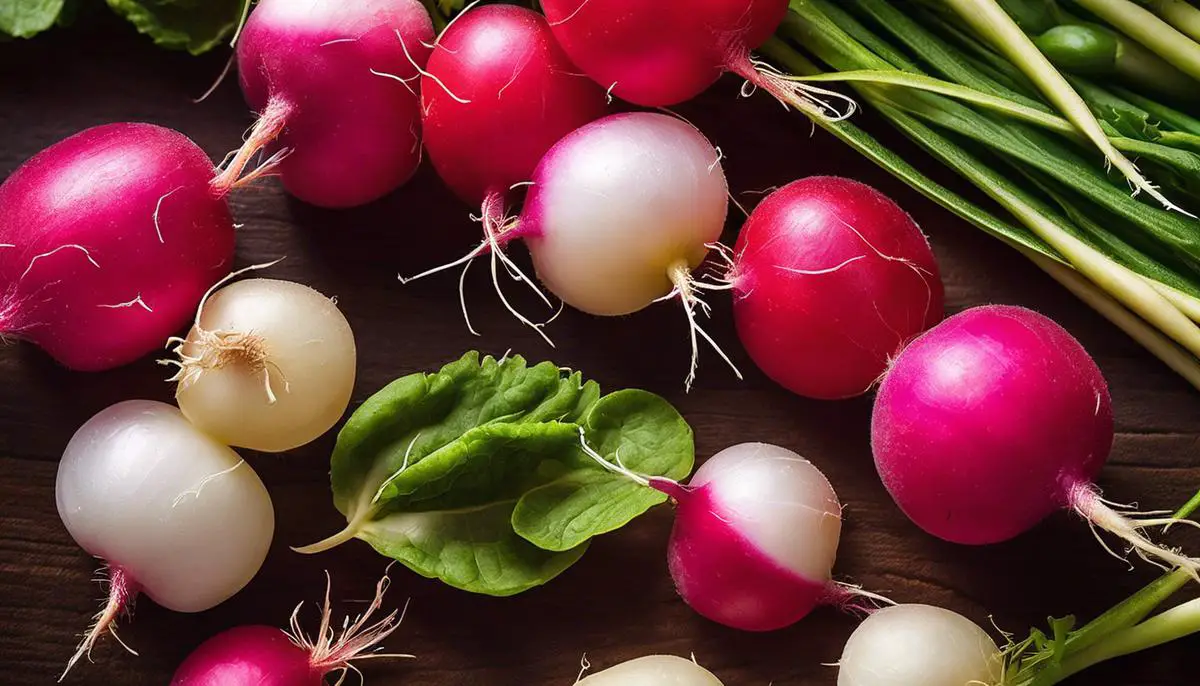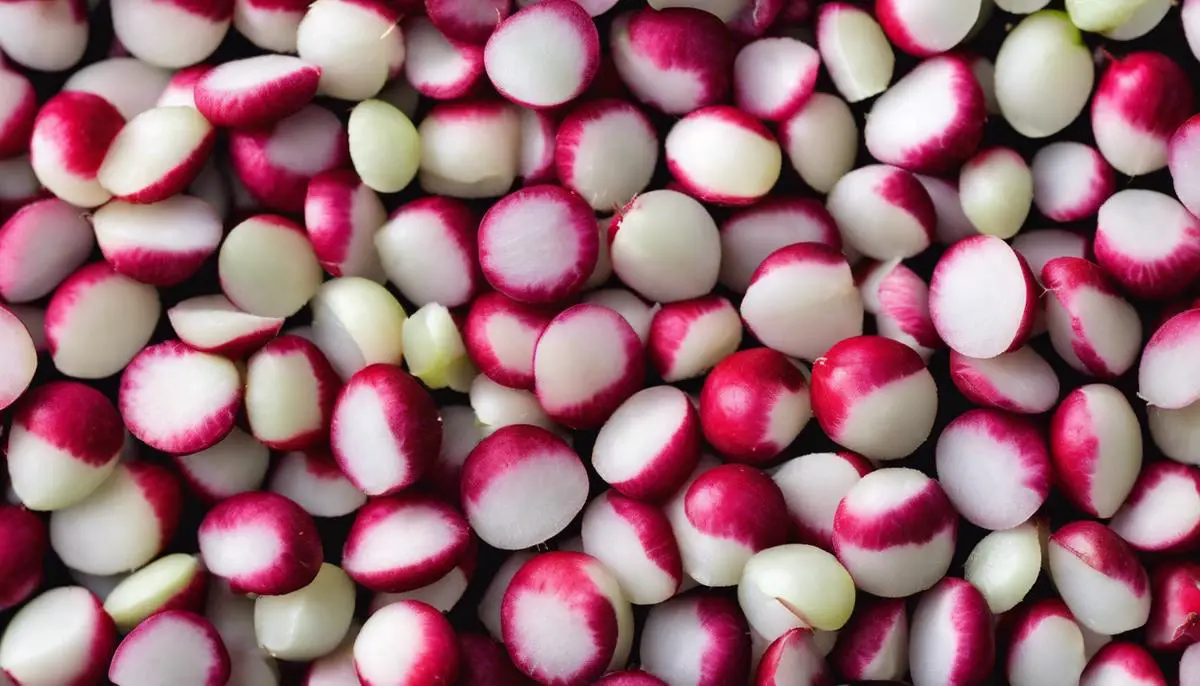Embarking on the pleasurable journey of gardening, it’s fulfilling to get your hands dirty and see the fruits of your labor come to life. An excellent beginning could be the humble radish; a hardy root vegetable, rewarding for both beginner and seasoned gardeners alike. This guide deep dives into everything you need to know about starting radish seeds, from understanding the basics such as their life cycle, optimal growing conditions including soil type, temperature, and pH level, to the best timeframe to kickstart seeding. Venture further to uncover the explicit seed starting process where we’ll walk through everything, starting from preparing your seed trays or soil, right up to sowing your seeds effectively, catering to watering needs, and caring through the germination phase.
Understanding the Basics
Kickstart Your Radishes: Expert Advice on Seed-Starting Basics
Radishes: they’re crisp, they’re zesty, and they’re incredibly rewarding to grow from seed. They are the sprinters of the vegetable world, breaking through the soil with a rapidity that is nothing short of breathtaking. So let’s dig into the basics of starting radish seeds, to ensure satisfying and successful gardening adventures every time!
Reader Poll: What online courses would interest you?
Before diving into planting, consider these supercharged radish fundamentals:
- Understand the Radish Varieties: It’s crucial to know that not every radish is the same. From the robust bite of the vibrant Cherry Belle to the mild crunch of White Icicle, researching and choosing the right radish variety can tailor garden outcomes to individual tastebuds.
- Optimal Planting Time: Timing truly is everything when it comes to radishes. For best results, plant the seeds three weeks before the last frost in spring or four weeks before the first frost in fall. Early planting promotes full growth while avoiding the hot summers that radishes tend to despise.
- Soil Preparation: Radishes flourish in loose, well-drained soil. Compacted or clayey earth can stunt growth, leading to underdeveloped and tough radishes. A light mix of garden soil, compost, or well-rotted manure encourages optimal radish development.
- Seed Spacing and Depth: The beauty of radish seeds is that they don’t require much fuss. Sow seeds about 1 inch apart and 1/2 inch deep. This gives them ample space to grow into plump, juicy specimens.
- Proper Watering: Radishes aren’t fans of drought. Keeping the soil consistently moist (but not waterlogged) ensures the development of tender, juicy radishes. Lack of water can lead to woody, less palatable radishes and slower growth.
- Harvest Time: Ready for the best part? Most radishes mature in just three to four weeks. When radishes are about an inch in diameter at the soil surface, they’re ready to be picked. Waiting too long can result in woody radishes, so keep a keen eye on them.
- Companion Planting: Don’t let radishes hog a whole garden space to themselves. They’re great friends with many plants. Partner radishes with cucumbers, carrots, or beans for a successful and high-yielding garden ecosystem.
Remember, no gardener was born knowing how to start radish seeds. Don’t worry if the first time doesn’t go exactly as planned. Each season brings new lessons and bountiful radishes. Just like cultivating these spirited bulbs, gardening skills, too, germinate and grow—with a sprinkle of patience, a dash of persistence, and a whole lot of love for the art.

Seed Starting Process
Kick-start Your Radish Seeding Adventure in No Time!
Starting a journey in planting radishes offers a real taste of success along the horticultural path. With radishes, one can expect speedy growth, vibrant hues, and peppy flavor, providing an adventure in every munch. Now that we’ve grasped the basics about radish varieties, sorting our gardening calendar, and preparing our soil, let’s delve into the actual planting intricacies for these zestful roots.
Subscribe to our newsletter!
Integrating Fertilizer Into Your Routine
Let’s not ignore the essentiality of fertilizers in our radish planting journey. Pick a balanced, slow-release variety for your beautiful radishes. With an NPK ratio of 10:10:10, you’ll be giving your plants an optimal balance of the primary plant nutrients: nitrogen, phosphorus, and potassium. Mix into the top couple inches of the soil at planting, and rest easy knowing your radishes are getting a full course meal as they grow.
Recognizing the Importance of Sunlight
Yes, the sun means a world of good to your radish babies. Ensure your radishes receive at least six hours of sunlight. If your yard doesn’t lend itself to that much sun, don’t worry. Radishes are forgiving and will still grow in partial shade, though not quite as quickly or vigorously.
Employing the Succession Planting Method
Radishes are a fast-growing crop. To maintain a constant supply, employ the technique of succession planting. Sow a new batch of seeds every 10-14 days while weather conditions remain favorable. This will ensure you a consistent harvest throughout the entire season, and it’s deeply satisfying to indulge in your own homegrown radishes regularly.
Combating Pest and Disease Control
Radishes are often troubled by root-maggots. Yellow sticky traps can be useful to monitor the initial flight of adults. Implement crop rotation as a preventive method against diseases. The use of light insecticide can be effective in some scenarios but consider turning toward organic solutions such as neem oil.
Ensuring Proper Thinning
As your radish seedlings appear, you’ll notice they are quite close together. Don’t worry, we planned for this remembering our seed spacing rules. It’s now time for thinning. Removing the excess seedlings will ensure the remaining ones will have enough space to grow into plump, juicy radishes. Grab a pair of gardening shears, and snip the excess plants at the soil level, making sure the remaining radishes are spaced at least two inches apart. Be vaulting in your thinning measures – remember, crowded roots produce stunted radishes!
Finally, let the joy of observing these bright red jewels pop out of the ground be the fuel to keep your green thumb throbbing. Embrace the waiting game, keeping in mind that radish gardening is all about patience and persistence. The perfect radish is a testament to the care and effort invested in it. May your radish adventure be every bit the riveting escapade that beginning such a fruitful hobby promises!

Care and Growing Precautions
Let’s move beyond the basics and delve deeper into the intricate details of radish cultivation. Becoming an expert radish grower requires paying attention to smaller, yet crucial factors that matters, such as the right type of fertilizer, the amount of sunlight, the succession planting method, pest control, and thinning.
First and foremost, choosing the right fertilizer can make all the difference between a bountiful harvest and a disappointing yield. Radishes, being a root crop, benefit from a phosphorus-rich fertilizer. Phosphorus aids in root development, so make sure you’re not skimping on this critical nutrient. Granulated or slow-release fertilizers can be mixed directly into your soil before planting, or liquid fertilizers can be used throughout the growth period to give a nutrient boost.
Sunlight plays a pivotal role in the growth of radishes. While they can tolerate partial shade, for the best results, place your plants somewhere they can bask in at least six hours of full, direct sunlight daily. This will ensure your radishes develop those vibrant colors and delightful crunch that we all love.
Succession planting is another effective technique with radishes that ensures a steady supply of crisp, tasty radishes throughout the season. Plant a new batch of seeds every 10-14 days, depending on the variety. You can then enjoy the thrill of harvesting fresh, homegrown radishes from early spring to late summer.
Pest and disease control are instrumental for the ultimate radish growing success. Watch for common pests like aphids, flea beetles, and root maggots, which can sabotage your crop. Regularly monitor your plants and take action at the first sign of damage. Organic solutions such as insecticidal soap or introducing beneficial insects like ladybugs into your garden can help control these pests.
Thinning is an integral part of growing radishes from seeds. Overcrowded plants can lead to stunted growth and underdeveloped bulbs. As your radish seeds germinate and reach about two inches tall, it’s time for thinning. Carefully remove extra seedlings, leaving about 2 inches of space between each plant. This gives your radishes ample room to spread, ensuring a flavorful and satisfying harvest.
With these advanced steps taken care of, radish growing from seeds can be a delightful and fulfilling hobby. Armed with these insights and your high-quality radish seeds, you’re ready to cultivate some of the tastiest garden treats that nature has to offer. So, get your gardening gloves ready, it’s time to delve into the soil and sow the seeds of success!

Moving forward in your enriching gardening journey, it’s essential to learn and assimilate the varied care procedures and growth precautions for your radish sprouts. Knowledge on when and how to transplant, if at all necessary, can make a world of difference to your gardening success. Being well-informed on potential adversaries like common pests and diseases can equip you with tools to address these challenges head-on. It’s all about giving your radish plants the care they deserve every step of the way, right from a tiny seed to a ripe, crunchy vegetable, ready to be harvested. With this guide, you are well on your way to a bountiful radish harvest, promising not just an enriching horticultural experience but also rewarding with wholesome, homegrown produce.

